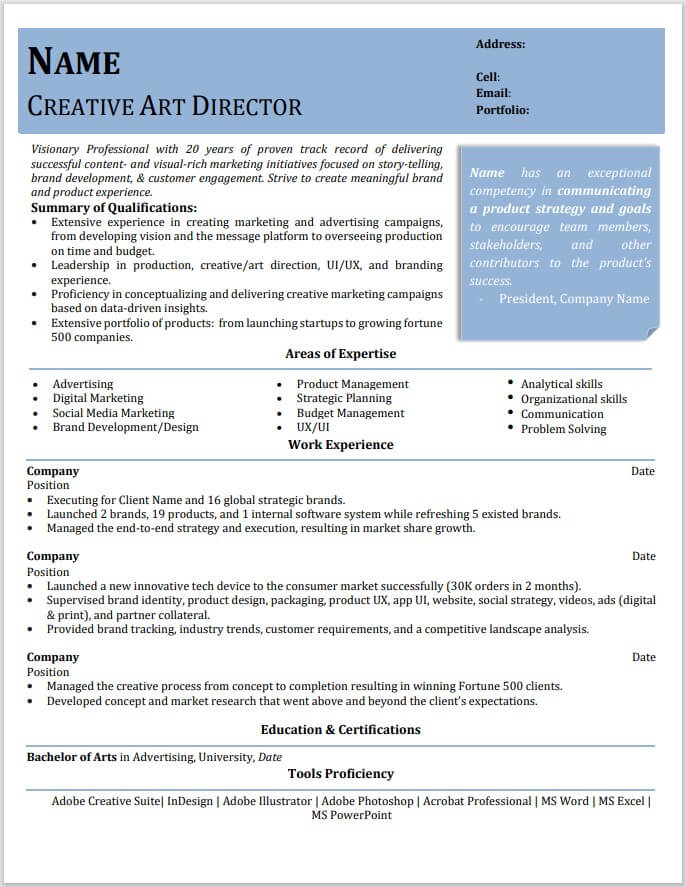In the life of every person, sooner or later, there comes a moment when they are either just starting to build a career, or are moving to a new step in the career ladder. First, they have to work on their resume. There is no doubt that all information contained in a resume must be relevant and make a good impression on the employer. As for the testimonials, not everything is so simple.
What Does Testimonial Mean?
Testimonials are written statements from people who have worked with the applicant. They can underline the applicant’s abilities and personal qualities. It helps recruiters and hiring managers to get an unbiased opinion on a candidate’s skills and whether they are the right fit for a particular position.
Read More: The Top 10 Skills Recruiters Are Looking For
3 Ways to Include Testimonials on Your Resume
Do I Need to Include Testimonials on my Resume?
Recently, adding testimonials has become a trend. But in reality, it all depends on the opening. If the company indicates the need for testimonials, you have no other choice.
Recruiters prefer resumes of no more than 2 pages, so the main rule is not to add anything extra. In addition, you can save the testimonials and use them as an additional advantage in the next stages of selection. But adding testimonials can be useful if you lack work experience and need to fill the empty space on your resume.
Pros and Cons of Testimonials
Adding testimonials to your resume has several benefits. One of the main benefits is that a resume with testimonials is more credible. Such candidates seem to be more reliable because the skills on the resume can be independently validated. Plus, if your recommender is somebody high up in a particular field or organization, this can also impress the recruiter or hiring manager.
In addition, a positive recommendation from an employer will become an example of constructive behavior. Not all people fire without conflicts. Therefore, having testimonials will show that you have remained on good terms with the team.
However, adding testimonials has its drawbacks. As mentioned, testimonials take up space. As a result, you may not have enough space to specify other important sections, especially if you already have a lot of work experience. In addition, at the stage of sending a resume, adding testimonials may be considered superfluous.
Types of Testimonials
Regardless of how great your work experience is, you may have already encountered other people in a professional environment. It can be:
- Your employer.
Employers are the ones who know better than anyone how effective you are at work. The employer can concisely describe your achievements, emphasize your personal qualities, confirm your reliability and punctuality.
- Colleague.
A co-worker with whom you worked on the same project can also write a good recommendation. They know firsthand your abilities and character. And if they were your subordinate, they can also confirm your ability to manage.
- Clients and partners
Do not forget about your satisfied clients and partners because they can also give a positive characterization. Their assessment criteria include not only the quality of the work but also your ability to conduct a dialogue and meet deadlines. So it is better to collect as much constructive feedback as possible to have an unbiased picture of you.
- Teachers and professors.
If you do not yet have work experience and, accordingly, there are no employees who could give you a description. That’s why you can ask your teacher for a testimonial. A student can request a recommendation from the dean of the faculty, head of practice, university professors, research staff, etc.
Criteria for Testimonials
- The best testimonial is the one that is backed up by facts. If it demonstrates various soft skills, then it can be checked at an interview or in the process of work. So don’t lie or exaggerate.
- In the digital age, LinkedIn can become the source for testimonials. Its advantage is that recruiters and hiring managers can easily check the validity of the data. Many job seekers come up with false facts, but the recruiter or hiring manager will be pleased to see confirmation of the testimonial right away. You can also use quotes from letters of recommendation making them available to the recruiter and hiring managers.
- If you are already interested in a specific position, it is worth choosing testimonials related to this profession. This way you confirm your relevant experience.
How Long Should a Testimonial Be?
The testimonial should be concise, usually one or two lines. Even if the recommender gives an extensive characterization, it is worth doing a testimonial in a sentence or two.
Read More: How Long Should a Resume Be?
The ResumeEdge team wants to provide successful personal testimonial example:
How Can I Include Testimonials on my Resume?
Looking at all of these work testimonial examples, we can indicate something in common. Thus, there are 3 ways to include testimonials on your resume
Complete each position with a testimonial
Under each vacancy, you can add different testimonials from your supervisors or managers. It is worth recalling that vague phrases are not suitable for testimonials. The testimonials should indicate your merit by adding statistics if it is possible.
Add an “Endorsements” or “Testimonials” section to your resume
If you have more than three testimonials from different people, you can create a separate section on your resume. This format will become more attractive and convenient. Moreover, if you have found, for example, five people who are ready to give you a testimonial, this says of your communication skills. It is also highly valued within the team and will not go unnoticed by recruiters and hiring managers.
Use testimonials to fill the space
Let’s say you have empty space on your resume. To use it wisely, you can add some testimonials there. This will not only show your positive characteristics, but it will also be a pleasant conclusion to your resume.
Conclusion
It’s up to you whether to add testimonials or not. It is not an obligatory part of your resume, but it does show the opinion of other experts about your professional qualities. And if you have a blank space on your resume, then you can fill it with such important information.
If you want to change your life, but you have problems while creating a resume, then resume writing services are always ready to help you. Professional writers from the ResumeEdge team can help you create an excellent resume based on your experience and skills, as well as feedback from other people.



